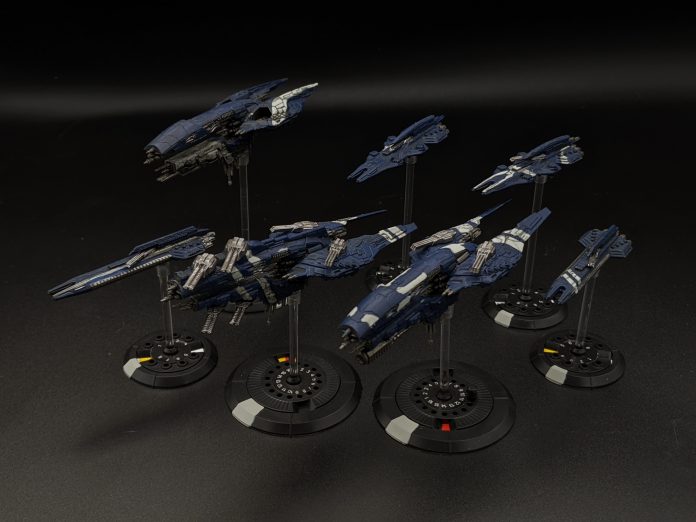If you read our article two weeks ago about Dropfleet Commander and have been wondering how best to get into the game, look no further: the Dropfleet Commander Two-Player Starter Set (available from TTCombat’s webstore for 65 GBP) is TTCombat’s recommended way to get started with this game. But is it the Goonhammer recommended starting point? That’s what we’re here to find out.
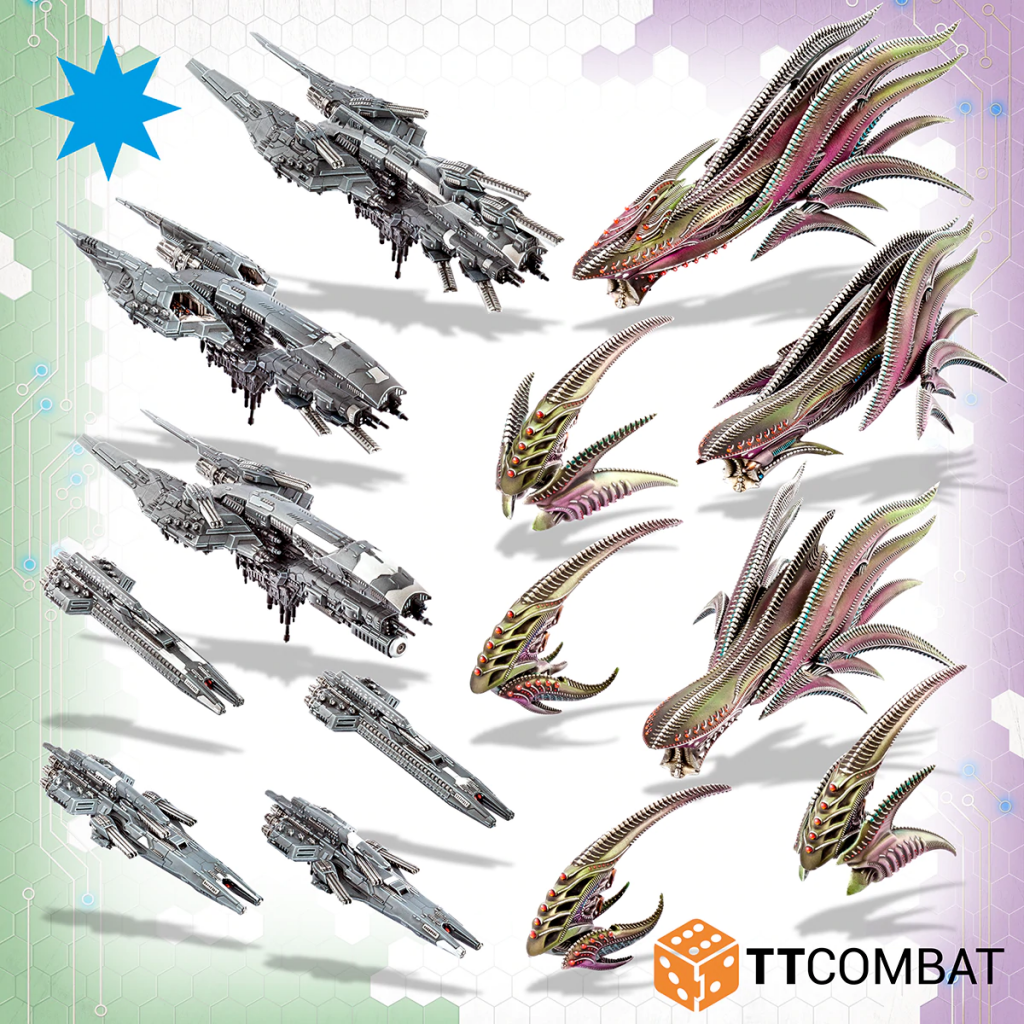
TTCombat were kind enough to provide us with a free review copy of the set, so let’s see what’s in there.
What’s in the box?
According to TTCombat’s webstore, “[t]his 2 Player set contains everything you need to get started in games of Dropfleet Commander,” and they aren’t lying. Included in this chonker of a box are:
- a UCM starter fleet (retail value: 40 GBP), which contains:
- 3 UCM cruiser sprues, each of which can be built in one of nine configurations; and
- 1 UCM frigate sprue, which builds four frigates that can each be built in one of four configurations (though you can only get two each of the same loadout);
- a Scourge starter fleet (retail value: 40 GBP), which the same selection of ships as the UCM fleet;
- bases and flight stands for each of the ships, with stickers to make the functional part of the bases useful and a set of ship name stickers for the bases for each side;
- two fold-out posters that combine to form a 3’x4’ play space on one side, and have some art of space battles in the setting on the other;
- a bunch of card tokens to represent the ground locations you’ll fight over; some space debris to avoid; the fighters, bombers, and ground assets you’ll be deploying; and a few to help keep track of various status effects you’ll encounter over the course of the game;
- the Battle for Earth book (retail value: 25 GBP), which includes some setting material, a few scenarios, and stat sheets for some of the newer units in the game, in addition to a bunch of Dropzone Commander stuff if you’re into that game as well;
- some fastplay sheets that contain the stats for a suggested starter fleet for each side, some useful reminders for gameplay, and some activation cards already filled out for your first game;
- some dice and a small tape measure.
All of this clocks in at 65 GBP, making it a fantastic value even if all you wanted out of it was one of the starter fleets and the Battle for Earth book.
The ships included in this set are all made from hard plastic, and are fairly forgiving to work with. The sprues are chunkier than I’m used to from Games Workshop, but the ships have a solid amount of detail and hold up well through the entire process of building, painting, and playing.
The only mandatory thing you’re missing here is the rules, which can be found at the Dropfleet Commander website. They also have an army builder that is pretty straightforward to use and kept up-to-date whenever a ship’s rules change, though the printed list output it gives you can be a little unwieldy to work with for your first couple games. You’ll get used to it though.
Another bit that’s conspicuously missing is the fleet strategy decks. While I understand why they’re not included in this set – they add an extra level of complication to a game that’s likely already very different from anything you’ve played before – they’d be a nice addition to your second or third game. I just went ahead and bought them so we could use them in our first game, but if you’re concerned that it might be a bit much, feel free to wait on them.
The Downsides
While this is a great set, not everything is perfect. The biggest “miss” here is the bases. They’re made to give you all the information you need about a ship at a glance. There’s a rotating dial that you slot in over a multicolored sticker that you can use to track which orbital layer the ship is in and whether it has a spike or not, but the fact that it’s not a “click” style rotating base means that it can sometimes be difficult to get it set up how you want it, but for the most part this works.
What doesn’t work so well is the other function: a set of slots for tiny pegs that correspond to numbers in a circle around the flight stand set up to let you track the ship’s current hull points. This is a neat idea, but after the first couple of times trying to move the peg without accidentally moving the ship, spinning the orbit/spike dial, or dropping the peg in one of the little windows that’s meant to show you the orbit/spike status, we gave up and grabbed a couple sets of RPG dice to track HP. I’d recommend you do the same, though I have found that just randomly sticking one of the pegs in so you have a tiny handle to help rotate the dial when you change orbit or take a spike is helpful.
Another thing that I’m not super enthusiastic about is the included playmat – the design is great and the size is just about perfect for an intro game, offering enough room to get to grips with how to fly your ships around while still being small enough to where you’ll be firing shots off by turn 2 at the latest. However, it’s printed on a poster sheet, and comes folded up, leaving some pretty serious creases. This makes it somewhat difficult to get it to lie flat, and means it will probably shift over the course of the game if you don’t tape the edges down, and can make it hard to get your ships to sit exactly where you want them. If you’re not super worried about ruining your immersion, marking out a 3’x4’ space will be fine, or you can invest in a mat made specifically for the game. For your first game, though, it’ll be fine.
These are minor gripes, though, and nothing you can’t solve fairly easily. Put this box up against the starter set for a game from any other company you care to name, and I think you’ll agree that not only is this an excellent value, but it’s an incredible jumping-off point for a budding fleet admiral.
The Reconquest Begins
So how does it play? Well, I was determined to find out. The first thing I did when I got my hands on this box was call up my friend Patrick to see if he was at all interested in flying tiny spaceships around and, thankfully, he was. He grabbed the Scourge, while I took the UCM, and we both set about building fleets to play a starter game.
You’ll note that the points costs here don’t match up one-to-one, and that’s not entirely unintentional. We used the sprues afforded to us to build fleets that had roughly the same complements of ships, but the balance between the factions meant that my chosen fleet was a little lower in points cost. If you stick to the recommended starter fleets (or communicate with your opponent to make sure you’re building fleets that are roughly equivalent in value), you can end up with forces that are a little closer in point value than this. But, if I’m honest, the point difference here is not the reason for the result of our game.
Condit’s UCM – 529 pts
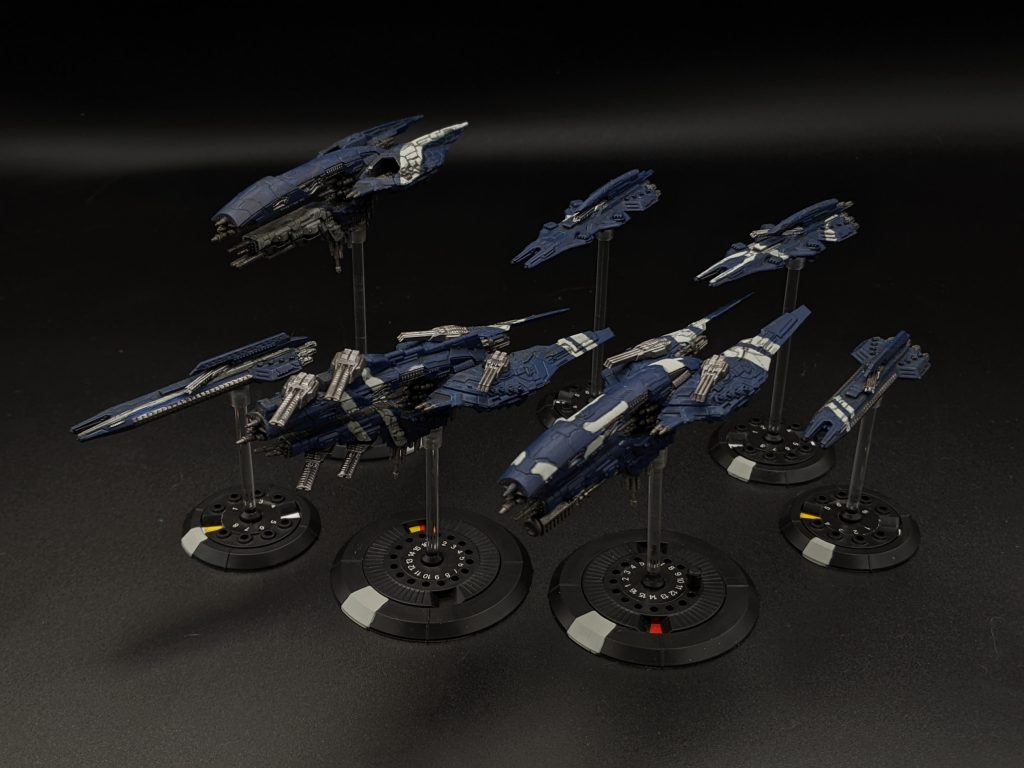
- Pathfinder Battlegroup
-
-
- 2x New Orleans Strike Carrier
- 1x Berlin Crusier
-
- Line Battlegroup
-
-
- 1x Seattle Fleet Carrier
-
- Vanguard Battlegroup
-
- 1x Moscow Heavy Cruiser
- 2x Taipei Missile Frigate
This list is mostly the recommended starter fleet, but I swapped out the 2 Toulons for a pair of Taipeis, a decision which I felt good about at the time, but in retrospect was probably a bit of a mistake (we’ll get to that later). The basic idea here is that the Berlin can get some Active Scan support from the Taipeis in the early game, light something up with its Burnthrough (6) laser, then the Moscow and Taipeis can move in and pour on the firepower. The Seattle is a bit of a wildcard, offering additional point defense to help fend off bombers earlier on, then having a potential upside once the fleets close with its 3+ lock mass drivers, and possibly flexing to use its bombers in a pinch if I need some extra damage.
Patrick’s Scourge – 566 pts

- Pathfinder Battlegroup
-
-
- 2x Harpy Frigates
- 1x Ifrit Cruiser
-
- Line Battlegroup
-
-
- 1x Hydra Fleet Carrier
-
- Vanguard Battlegroup
-
- 1x Shenlong Heavy Cruiser
- 2x Gargoyle Strike Carrier
Patrick’s list is also a slight twist on the recommended starter fleet, and it looks like it’s going to be a real pain to deal with. The Ifrit’s furnace cannons are a potent counterpart to my Berlin’s laser, and the Shenlong packs a solid number of 2-damage attacks on a platform with Partial Cloak, which means it can never take a Major Spike, limiting the range I’ll be able to shoot it from until I’ve already crippled it. The Gargoyles are pretty standard strike carriers, but the Harpies come with 2-damage Oculus Beams, making them potentially very deadly if they get in close, which isn’t a huge “if” when you consider their 12” thrust. However, he’s swapped out the Wyvern for a Hydra, trading about half of the cruiser’s prodigious Close Action armament for 5 wings of fighters or bombers.
The Mission
We set up a couple of clusters and debris around the board in a more-or-less symmetrical manner. As a bit of a treat to myself in advance of this first game, I purchased one of TTCombat’s Modular Space Station kits, which are absolutely incredible – the instructions don’t walk you through how to build a specific station, but rather just tell you how the various sorts of pieces interconnect and let you build whatever you want. I made a pretty decent size station that I thought was pretty cool, then put it in the center of the table as a showpiece objective. We nominated two of the clusters and the station to be “critical locations,” which can give you points if you have the most ships within range of them in a scoring round, and the remainder of the scoring was through holding and contesting clusters.
One of the coolest things about Dropfleet from my perspective is how it handles deployment: while some scenarios will recommend that your fleets are deployed on the table, most will begin with your ships starting off the table, then moving on from your board edge on a given turn based on the deployment rules you’ve chosen. For this match, we went with Battlelines, which just means that everything starts off the board, but all comes in the first battle round in normal activation order.
Round 1
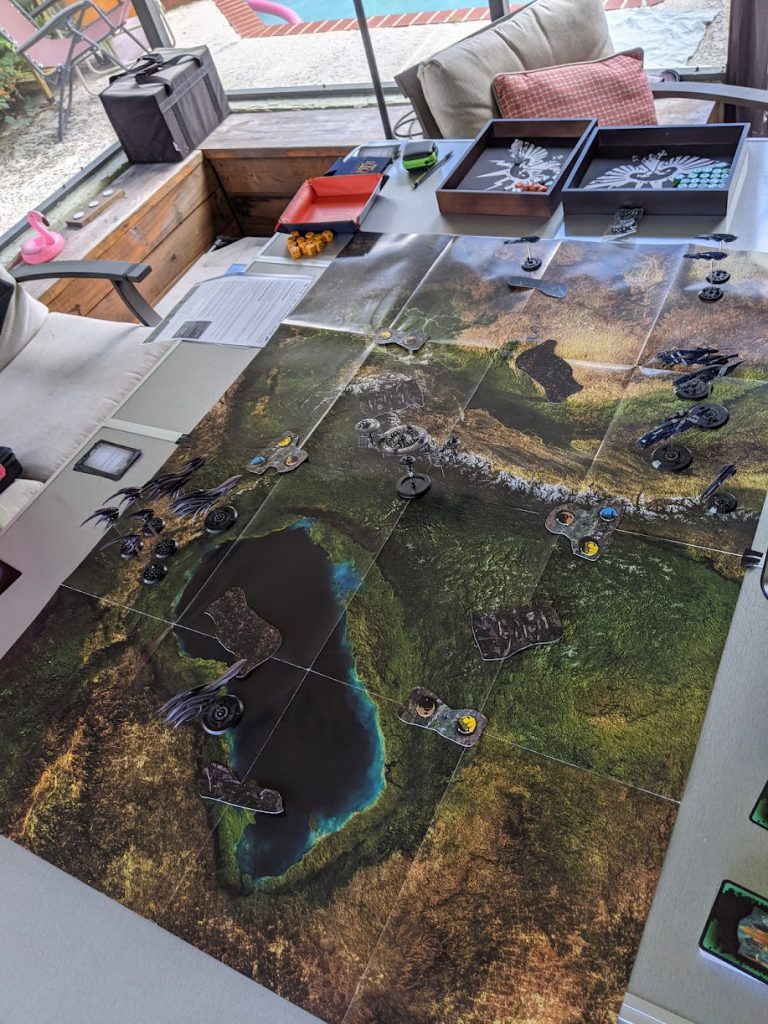
The first round was relatively uneventful. Patrick kept his fleet largely together with the exception of the Hydra, which went up his right flank to challenge my ships. My cruisers stayed together on my left, while my Taipeis went up the right and the two strike carriers went on Max Thrust to get closer to the clusters I wanted to drop in. In retrospect, this wound up not being the brightest idea I’ve ever had, as it put one of them at risk earlier than I needed to and may have delayed my drop by a turn, but I’d soon have bigger problems.
Round 2
Patrick’s fleet made a play for the center of the board while I hung back a little bit. My thought was that the Berlin and Moscow could put out some longer ranged firepower, then I could throw out some fighters and maybe rush in with the Taipeis next turn.
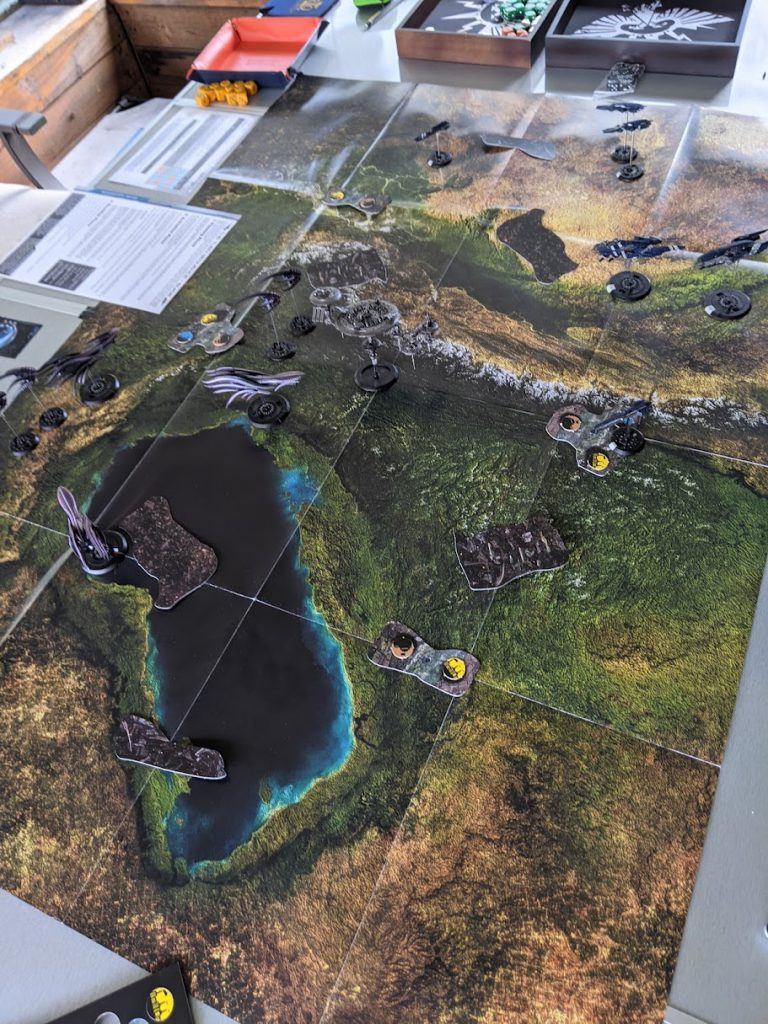
Eagle-eyed readers may notice that something’s missing from this photo, though: my Berlin moved up, took a shot with its laser on Active Scan, and then promptly got murdered by Patrick’s entire flreet. Thankfully, he was slow-playing his Gargoyles to make sure they’d be safe, which meant they weren’t able to drop this turn. That would turn out to be cold comfort for what was to come, though.
At this point, the writing was on the wall, and I knew I’d have to make something happen if I had any hope of winning the game. I focused my Seattle and Moscow on his Ifrit in the middle of the board, and continued to push into the center under cover of his fighter screens.
Round 3
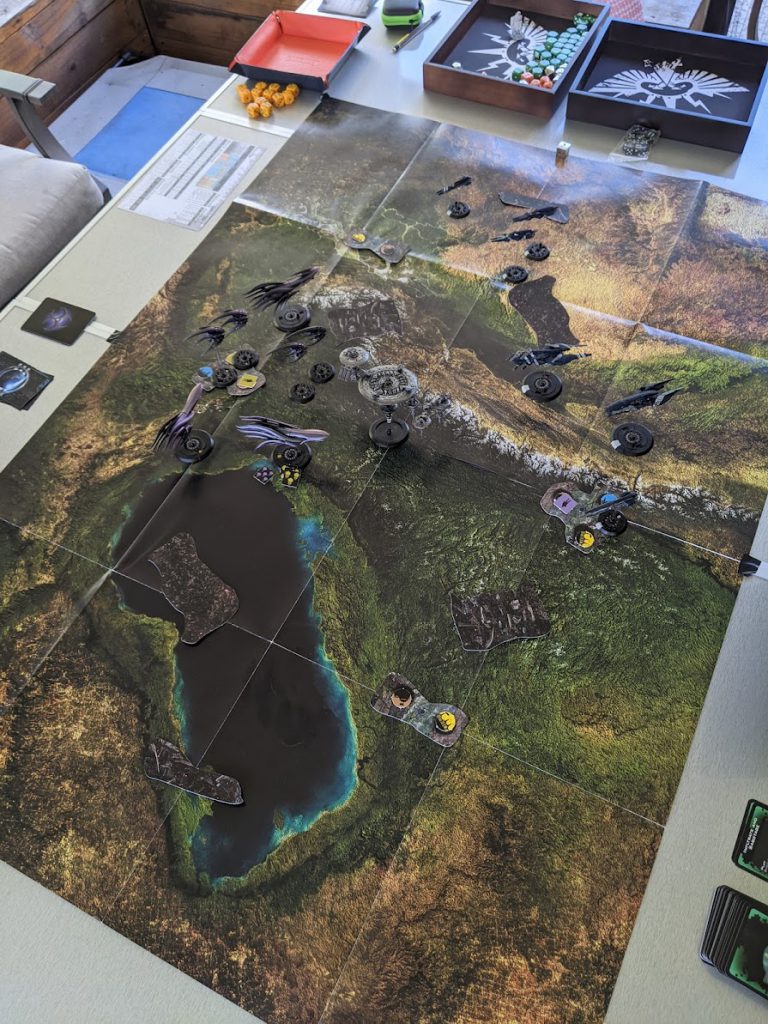
I got some lucky hits off on the Ifrit, and pushed my Moscow up in the hopes that, between its prodigious number of mass drivers and its close action weapons, it’d be able to put out enough damage to take the thing off the board. Unfortunately, I was only able to drop it to 1HP, so Patrick responded in the way I knew he would: he rammed me.
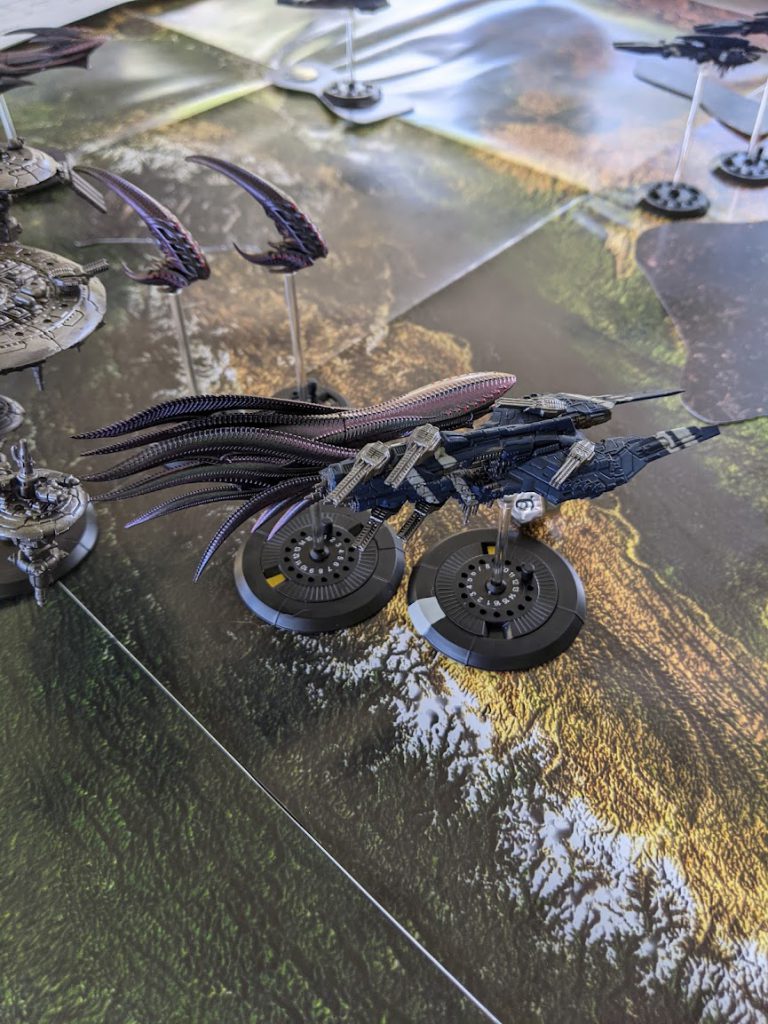
Thankfully, he missed. I pushed my Seattle up and managed to clear one of his Strike Carriers off the board, leaving us roughly at parity – I had one more frigate than he did and had managed to cripple his Shenlong, finally getting rid of the Partial Cloak rule, but the Shenlong retaliated by tearing into my Taipeis while his Hydra’s bomber wings slowly picked apart my larger ships.
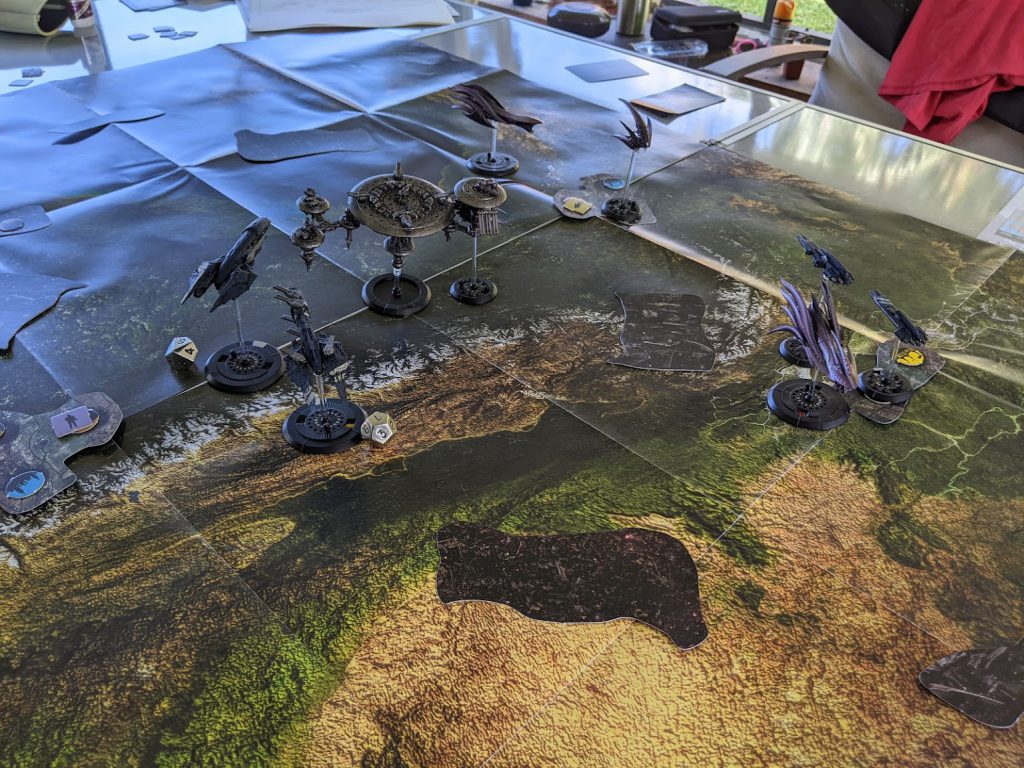
He finally managed to take out the Seattle, leaving me with two Strike Carriers, a Taipei, and my Moscow.
Round 4
Of course, that was too much UCM on the board for Patrick’s taste, so he brought his Shenlong around on Course Change orders, blasted a hole in the thing, and used his remaining frigates to clean up.
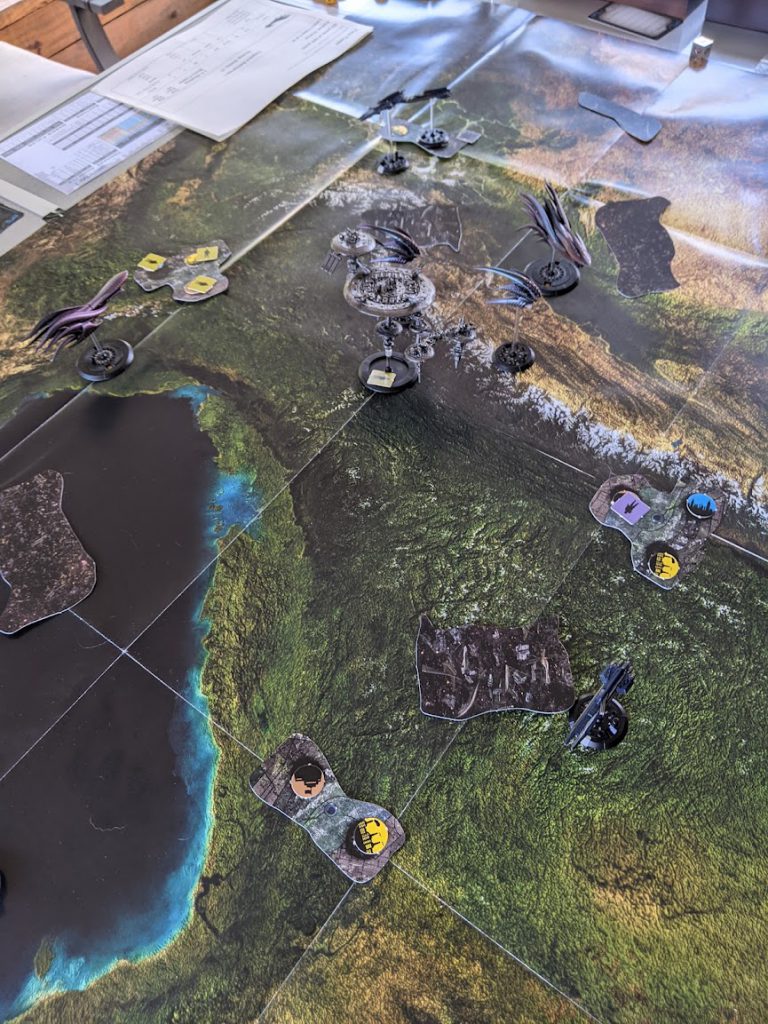
At this point, the writing was on the wall, so we called it. The Scourge may have won this time, but we’ll be back for another shot.
The Takeaway
All in all, this was an incredibly enjoyable game for a pair of starter sets squaring off against one another. The Taipeis didn’t really do anything for me, and I probably would have gotten more mileage out of a pair of Toulons, but I honestly don’t think that would have saved me. That being said, the game was easy to pick up and quick to play, letting us get in a solid afternoon of space opera-esque fleet battles without ever feeling like things were dragging or that we didn’t know what we wanted to do next.
Is it worth it?
In a word, yes. A lot of games have trouble at “beginner” points values, as they’re tuned to work at higher points values and can fall apart when you don’t have enough points to take everything you’re expected to have. As an example, as much fun as games of 40k Combat Patrol can be, they’re very swingy, and things can get out of control once one player gets the advantage.
That’s not the case here, though. The Dropfleet rules scale very nicely down to this level of play and make for an interesting game to get started. In addition, while the recommended fleets are solid choices, there are enough options on the sprue that if the “stock” fleets aren’t to your liking, you can make one that works for you. And if you’re looking for a starting point to build up to a tournament-standard 1250 point list, this is about as good of a starting point as any.
